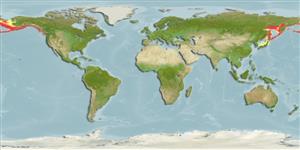Environment: milieu / climate zone / depth range / distribution range
Ecologia
marinhas demersal; intervalo de profundidade 0 - 700 m (Ref. 50593), usually ? - 91 m (Ref. 2850). Temperate; 67°N - 35°N, 130°E - 125°W (Ref. 54599)
North Pacific: Korea and the Sea of Japan to the Sea of Okhotsk, Bering Sea, and Barkley Sound, Canada. Reported from the Alaskan Beaufort Sea (Ref. 28503).
Length at first maturity / Tamanho / Peso / Idade
Maturity: Lm 27.3, range 21 - 32 cm
Max length : 49.0 cm TL macho/indeterminado; (Ref. 56370); common length : 33.5 cm TL macho/indeterminado; (Ref. 4883); peso máx. Publicado: 1.7 kg (Ref. 56527); Idade máx. registada: 34 anos (Ref. 55701)
Espinhos dorsais (total): 0; Raios dorsais moles (total): 61-69; Espinhos anais 0; Raios anais moles: 48 - 58; Vértebras: 39 - 40. Dorsal origin above posterior part of eye. Caudal rounded at edges. Pectorals bluntly pointed.
Adults feed on hydroids, worms, mollusks, and brittle stars (Ref. 6885). Marketed frozen and eaten fried, microwaved and baked (Ref. 9988).
Each individual spawns from 8 to 11 batches (Ref. 39301). Spawning occurs primarily in shallow water but for large females spawning may take place in waters to a depth of around 50 m (Ref. 119537). Undergoes spawning and feeding migration (Ref. 119537).
Vinnikov, K.A., R.C. Thomson and T.A. Munroe, 2018. Revised classification of the righteye flounders (Teleostei: Pleuronectidae) based on multilocus phylogeny with complete taxon sampling. Molecular phylogenetics and evolution, 125:147-162. (Ref. 122998)
Categoria na Lista Vermelha da IUCN (Ref. 130435)
Ameaça para o homem
Harmless
Utilização humana
Pescarias: altamente comercial; peixe desportivo: sim
Ferramentas
Relatórios especiais
Descarregue XML
Fontes da internet
Estimates based on models
Preferred temperature (Ref.
123201): 0.2 - 6.1, mean 3.4 °C (based on 33 cells).
Phylogenetic diversity index (Ref.
82804): PD
50 = 0.5156 [Uniqueness, from 0.5 = low to 2.0 = high].
Bayesian length-weight: a=0.00832 (0.00722 - 0.00958), b=3.08 (3.04 - 3.12), in cm total length, based on LWR estimates for this species (Ref.
93245).
Nível Trófico (Ref.
69278): 3.5 ±0.1 se; based on diet studies.
Generation time: 7.8 (6.8 - 11.0) years. Estimated as median ln(3)/K based on 12
growth studies.
Resiliência (Ref.
120179): Baixo, tempo mínimo de duplicação da população 4,5 - 14 anos (K=0.1-0.15; tm=4-10; tmax=34; Fec=1 million).
Prior r = 0.33, 95% CL = 0.22 - 0.50, Based on 5 stock assessments.
Fishing Vulnerability (Ref.
59153): Moderate to high vulnerability (50 of 100).
Climate Vulnerability (Ref.
125649): Low vulnerability (23 of 100).
Nutrients (Ref.
124155): Calcium = 12.4 [5.7, 51.3] mg/100g; Iron = 0.246 [0.127, 0.464] mg/100g; Protein = 15.7 [13.4, 18.4] %; Omega3 = 0.36 [0.18, 0.74] g/100g; Selenium = 13.5 [4.6, 46.8] μg/100g; VitaminA = 9.24 [1.88, 45.54] μg/100g; Zinc = 0.298 [0.160, 0.721] mg/100g (wet weight); based on
nutrient studies.
